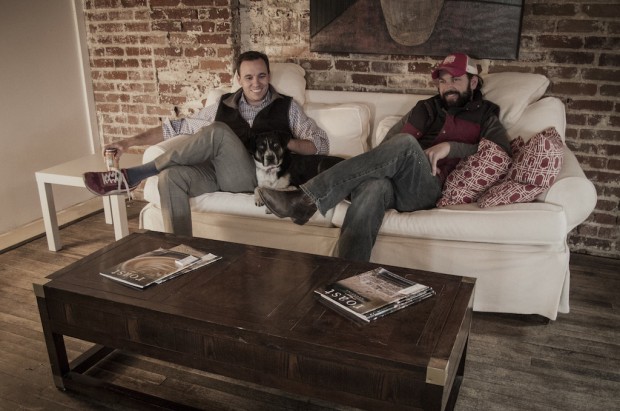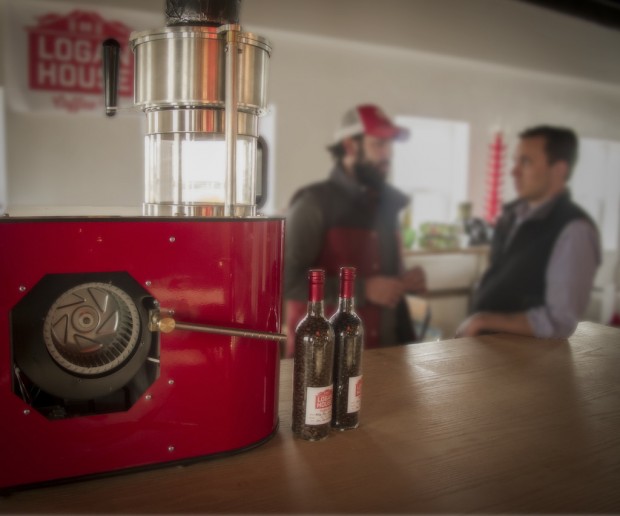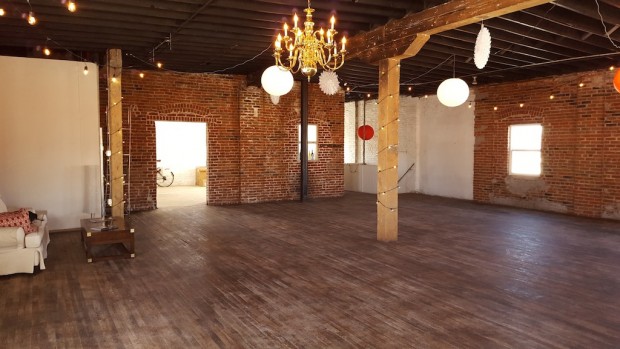
Brooks Gagstetter (left) and Andre Janusz of Logan House. All photos courtesy of Logan House Coffee Company.
While the comparison of specialty coffee to wine is well worn at this point, avoiding it has become an increasingly tall order given the ever-strengthening links between these two beverage cultures.
Apart from parallel focuses on quality, craft, varietal and terroir, coffee at this point has also been aged in wine barrels, served in wine glasses, even cold-brewed and bottled in wine bottles. The Logan House Coffee Company has been driving it home as well, both literally and figuratively, as they package their fresh-roasted whole-bean coffees in recycled wine bottles, then deliver them to customers’ homes.
Logan House collects used wine bottles left over from the tasting rooms of a couple different Colorado wineries. The wineries don’t reuse the bottles, therefore it’s a free wastestream byproduct that the coffee company returns to commercial use. LHCC sanitizes the bottles, strips away the labels, re-labels them with their brand and product information and seals them anew with a proprietarily altered cork that features an incorporated one-way degassing valve.
“We modify a tasting cork,” LHCC Co-founder and Head Roaster Andre Janusz told Daily Coffee News, explaining that they order a certain tasting cork by the thousands from a manufacturer and then modify each one by hand. The result is a clean, sealed wine bottle looking as good as new, handsomely displaying approximately 10 ounces of LHCC’s roasted coffee inside.
LHCC has some wholesale accounts, and some of those also sell their coffee by the bottle on retail shelves. By volume, Janusz estimates that roughly 70 percent of the coffee they roast overall ends up in bottles, mostly delivered to people’s homes either by pickup truck or by bicycle if possible. “We were looking for a package that was recycled, or at minimum, recyclable,” said Janusz, adding that the uniqueness of the idea has made them well known as “the wine bottle guys.”
“I have a preference for the tinted bottles,” said Janusz. “The more amber, or like a chardonnay sort of yellowish bottle, those are my favorites. But our customers like the clear ones.” Janusz is cognizant of the idea that direct light might cause beans to age or stale faster than beans stored in darkness, although without having scientifically tested and proven that fact for himself, his bottle preference is mostly based on aesthetics. “I’m not sure if that really effects it or not,” said Janusz of the beans’ exposure to light. Ultimately his concern is more over the possibility that customers enjoy the presentation so much that they don’t consume the coffee quickly enough. “We’ve done a pretty good job, I think, of convincing them that while it looks really cool in the wine bottle, fresh coffee is better,” said Janusz.” So… drink it.”
Founded by adventuresome duo Brooks Gagstetter and Andre Janusz three years ago in the tiny high-elevation Rocky Mountain town of Grand Lake, Colo., LHCC is currently in the process of moving about 100 miles downhill into a temporary space in the RiNo neighborhood of Denver this month. It’s an interim space intended to house production and possibly some special events in the run-up to the build-out of the first Logan House retail café, which is slated for inclusion in an upcoming mixed-use cluster of food-related businesses called the Stanley Marketplace in the spring of 2016.
Apart from some innovative ideas about packaging and delivery, LHCC also apparently has a predilection for storied structures. The company takes its name from what municipal records used to call the house that Janusz eventually bought and transformed into a single-family home. That structure, originally a 10-bedroom house with two bathrooms, was listed in vintage city annals as a hotel, although it may or may not have actually been a house of ill repute. “I wouldn’t be surprised to learn that you could get a room by the hour in that place,” Janusz told Daily Coffee News. “I don’t know that for sure, but I’d bet on it if I were a betting man.”
Yet with the coffee scene booming and the lion’s share of their customers located in Denver, the company has moved into a 3,500-square-foot warehouse space at 3200 Walnut St. that’s slated for demolition within the coming year. “It’s really a cool old factory building,” said Janusz. “It’s a shame they’re going to level it.” Before that happens, LHCC is considering making the most of it, given that their two Sonofresco 2-pound fluid bed roasters and other production gear will only occupy about 1,000 of those square feet. They’ve chatted with area chefs about the possibility of foodie pop-ups, as well as with yoga instructors about the possibility of some kind of “yoga at the roastery” series.
The upcoming Stanley Marketplace, meanwhile, will be a community of local businesses, mostly food-oriented, housed within a 140,000-square-foot facility formerly owned by Stanley Aviation. The site was used by the aerospace company as its original military aircraft ejector seat factory. In it, LHCC plans to roast coffee on site and serve it both brewed and potentially via a Modbar espresso installation. “I’ve been in love with the Modbar espresso machine ever since I first saw it at Cuvee Coffee in Austin,” said Janusz. “I’m really impressed with that machine, so I think we’re probably going to head that direction, but nothing’s really etched in stone.”
In the meantime, Logan House has its plate full just keeping up with holiday season production in the midst of getting the Sonofrescos relocated and up and running in the interim space. “We’ve yet to turn them on in the new space,” said Janusz. “We’re working on that right now.”
Howard Bryman
Howard Bryman is the associate editor of Daily Coffee News by Roast Magazine. He is based in Portland, Oregon.









Comment